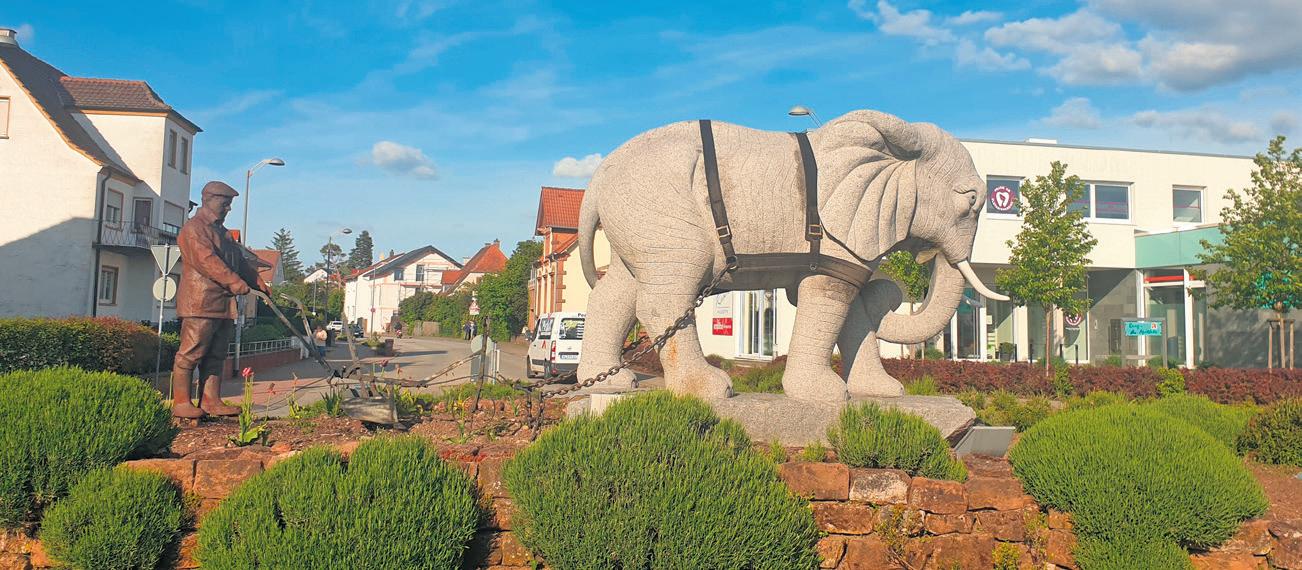
6 minute read
ABC in KMC: Enkenbach-Alsenborn and Hochspeyer
by Gina Hutchins-Inman, 86th Airlift Wing Public Affairs
The next stop on our journey around Kaiserslautern County leads us to the Union Community of Enkenbach-Alsenborn and Hochspeyer. It is situated on the northern tip of the Palatinate Forest and also borders Donnersberg County. A Union Community is an administrative territorial community composed of a group of individual towns or villages.
Originally Enkenbach-Alsen-born consisted of the towns of Enkenbach, Alsenborn, Mehlingen, Baalborn, Neuhemsbach and Sembach and was a separate union community. In July 2014 it was merged with the community of Hochspeyer along with Fischbach, Frankenstein and Waldleiningen.

Today the union community has 19,700 inhabitants and about 1,500 members of the Kaiserslautern Military Community have found homes in the towns and villages.
Stone age, iron works and glass recycling
Findings from the neo-stone age and mounds from the Iron Age suggest that the area was populated in pre-historic times. Varying traces along an old transit road indicate that there were different settlements throughout early history.
Alsenborn was first officially mentioned in chronicles in the year 872 close to the source of the Alsenz stream. A monastery was founded in the nearby village of Enkenbach, meaning “stream of the enkens” (herdsmen) in 1148. Construction of the Klosterkirche, a monastery church, was completed about 1272 and the sandstone structure, in a mixture of ornamental Roman and Gothic elements, is still the most prominent landmark.

The former monastery garden was transformed into a relaxing herb and flower garden, with a fountain and a playground along “Wäschbach” (washing stream) used for laundry in former times.
As a favorable traffic network to Kaiserslautern and connection to the railroad system, Enkenbach flourished in the iron and metal industry, which led to an increase in population in 1871. In 1969 both villages were combined under the name Enkenbach-Alsenborn.
From 1953 to 1995 the community was also partially home to Sembach Air Base, the 86th Fighter Wing and 17th Air Force. In the meantime, the area has been developed into a commercial center with quick access to A63 and various enterprises, such as Becker, the largest waste disposal company in the region, a glass recycling firm, a storage area for heavy Army vehicles and a DHL distribution center.
Perfume, circus and the center of the world
The Parfuemmuseum in Baalborn offers a glimpse of the art of creating perfumes and was designed based on the famous book “The Perfume.” It leads visitors into a cellar decorated with flacons with tender rose and lavender scents, a distillery and ingredients for a multitude of fragrances in a 17th century setting.
The Bajasseum, a tiny museum resembling a circus tent focuses on the theme and is located in Alsenborn. The town is commonly referred to as the “home of rope dancers” or “Bajasse” based on people who made livings as musicians, marionette players, acrobats or animal tamers, and roamed the countryside as circus folk during the summers in the late 19th century.

The Weltachse (world axis), or center point of earth, can be found between Johanniskreuz and Waldleiningen deep in the forest. At least this is what local poet Paul Münch proclaimed and the stone to mark this fact was inaugurated in 1964. Every year it is “smeared and protected” in a solemn ceremony in an effort to save the planet, a remedy against climate change?
There are several natural fountains within the community and both the Billesweiher and Schwarzweiher lakes are perfect venues for leisurely strolls in the forest. Castle ruins in Diemerstein and Frankenstein, near Hochspeyer, from the 12th and 13th centuries speak of medieval times and a chapel with a mighty belltower in Neuhemsbach that can be seen from afar marks the remains of a former castle.
From maneuvers to fields of heather
Until 1912 the area around Mehlingen was completely covered with forest until the German Army administration in Kaiserslautern was granted a drill ground at Kleiner Fröhnerhof. In 1938 first maneuvers took place at Grosser Fröhnerhof. Exercise operations with constant soil damage then fostered the emergence of heather. As of 1945 the area was used as a maneuver site by French and U.S. Armed Forces. In 1994 it was decommissioned and returned to the government. The total area is 410 hectares and 150 thereof are comprised of heather, making it one of the largest heather landscapes in southern Germany. Numerous trails with educational stops along the way invite you to leisure strolls. At point “Höhe 325°” you have a panoramic view over the countryside with Donnersberg in the distance, and was proclaimed a nature preserve area in 2001.
Leisure, soccer and the police
Other leisure activities include bike and hiking trails, soccer-golf in Sembach, geocaching and a rope park. An array of clubs and associations offer sports, fishing, martial arts, tennis, basketball and bowling.
Tor, Tor, Tor!!! — was the victory cry at the 1954 FIFA World Cup championship in Switzerland. Alsenborn is proud of its famous soccer players Fritz and Ottmar Walter, both born in Kaiserslautern. Later, Fritz moved to Alsenborn with his wife Italia. Fritz was team captain and Ottmar player when Germany won the world championship in 1954. During his time as a coach for Sportverein Alsenborn in the 1960’s the team almost made it into the Bundesliga (premier league).

The Bereitschaftspolizei Rheinland-Pfalz is a training and specialization center for the police forces in the state. Teams from the center also assist in large-scale operations throughout the Federal Republic, such as demonstrations and protests, rescue missions or provide for safety during soccer matches.
Summer sun and festival fun
Alsenborn and Hochspeyer offer splash baths with slides and grassy sunbathing areas, while the pool in Mehlingen has a separate baby pool and a beach volleyball court. Colorful festivals take place throughout the summer months in every town. The “Kuckucks Kerwe” in Enkenbach is in July and Alsenborn celebrates in September. A lawn-tractor race takes place in Sembach every June.
Fun facts
Circus people helped farmers plow their fields with elephants! There is a large granite elephant pulling a plow to commemorate the times at the traffic circle entering Alsenborn.
Former Sembach Air Base was located in two counties. The flightline section in Kaiserslautern County and the admin/housing area (Heuberg) about a mile further north in the Union Community of Winnweiler in Donnersberg County.
One of the largest solar parks in Germany is in the former Sembach flightline area. About 40-50 stork families find summer homes in the re-natured (former runway) area and can be spotted flying over the village in large flocks.
For more information, visit: www.enkenbach-alsenborn.de


